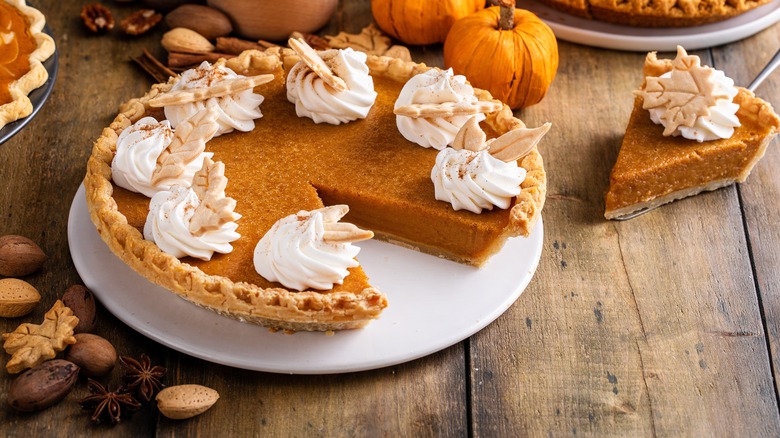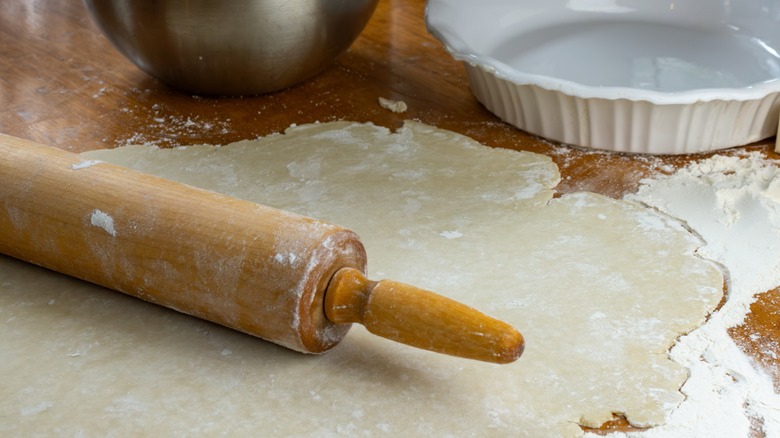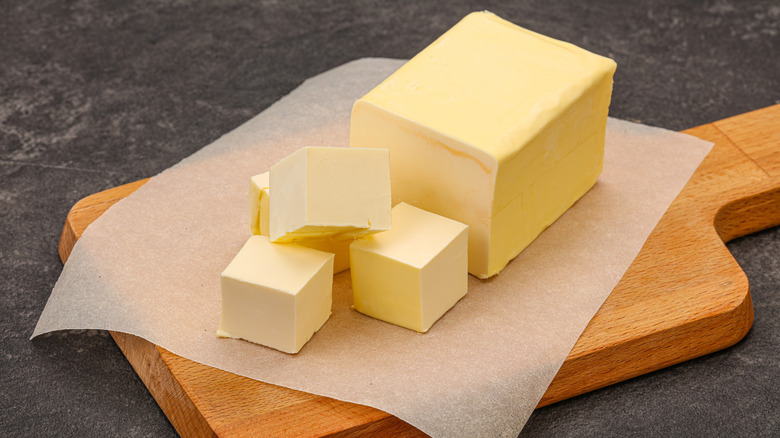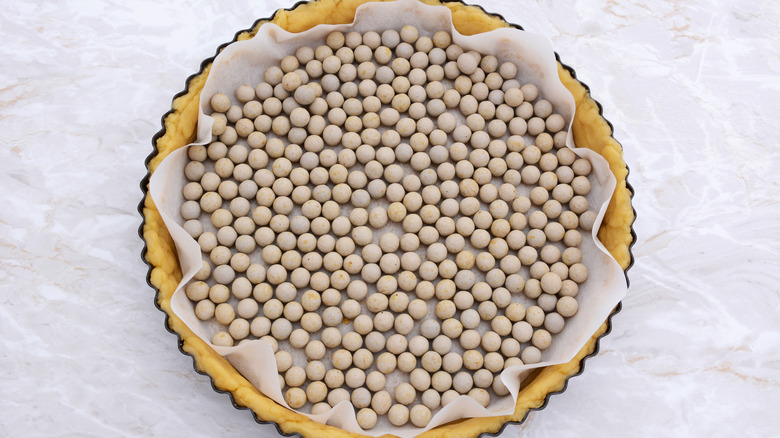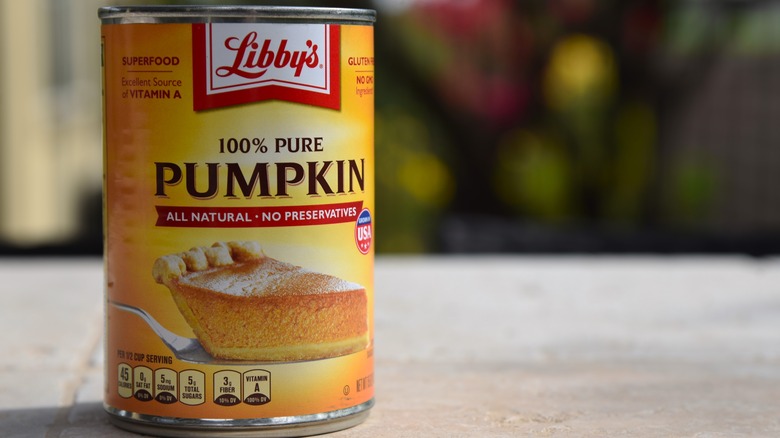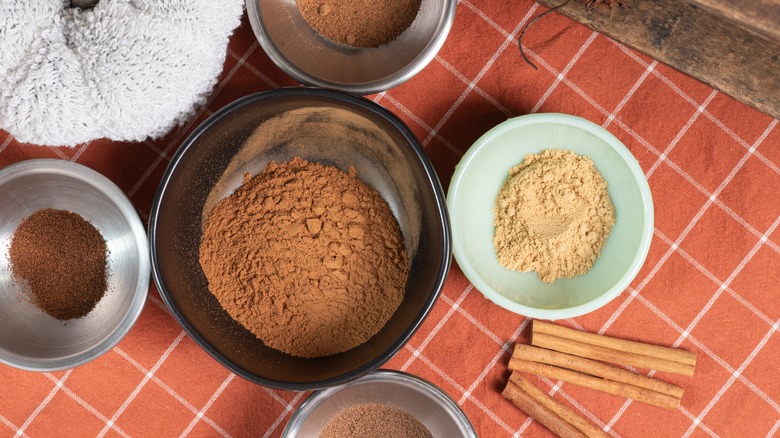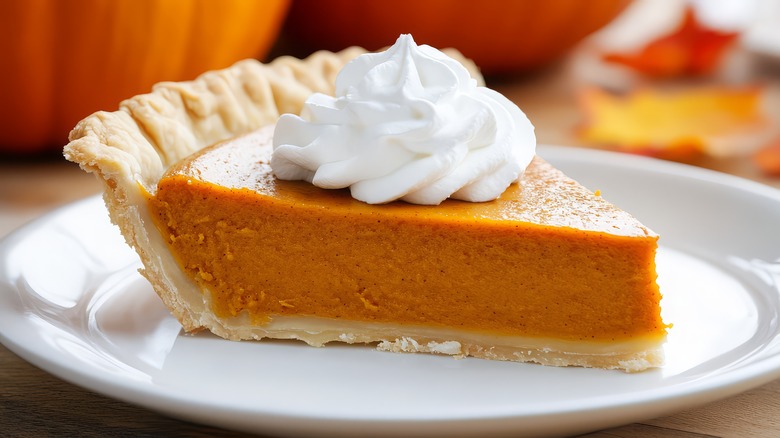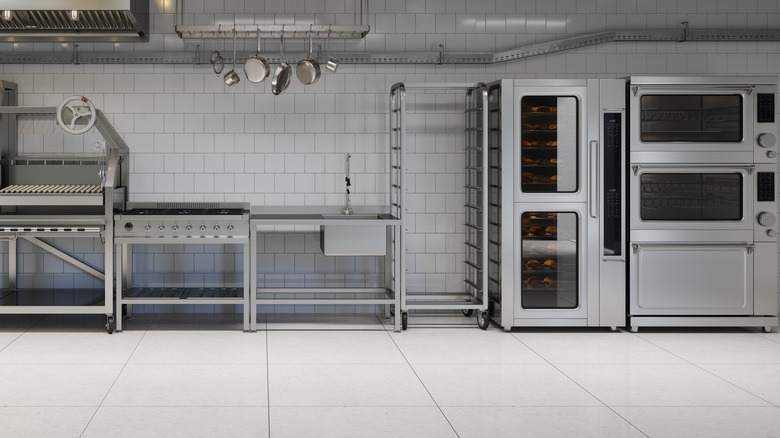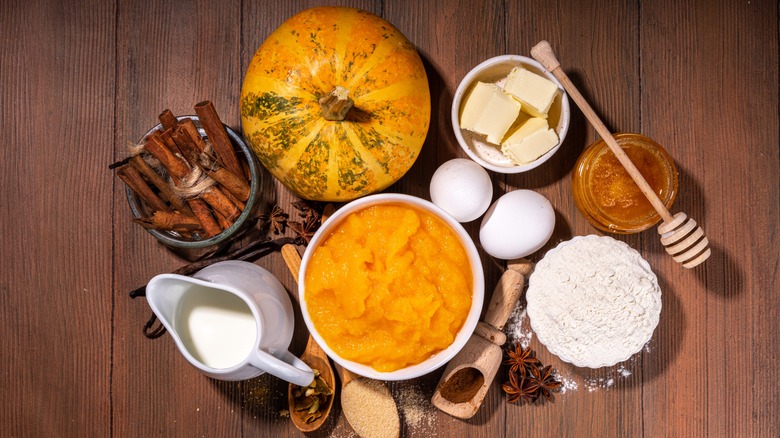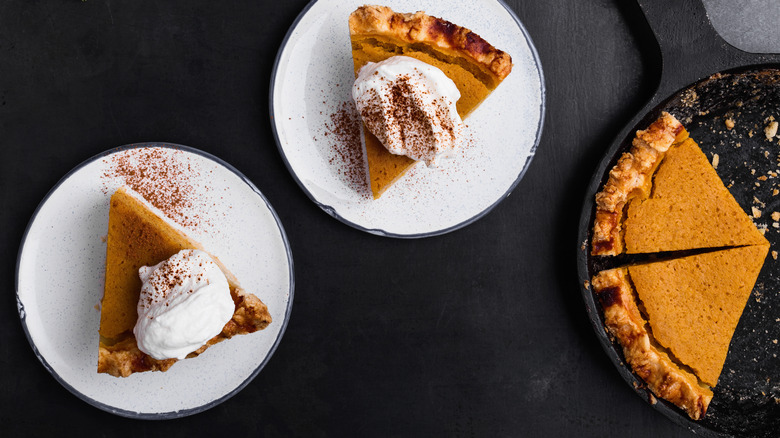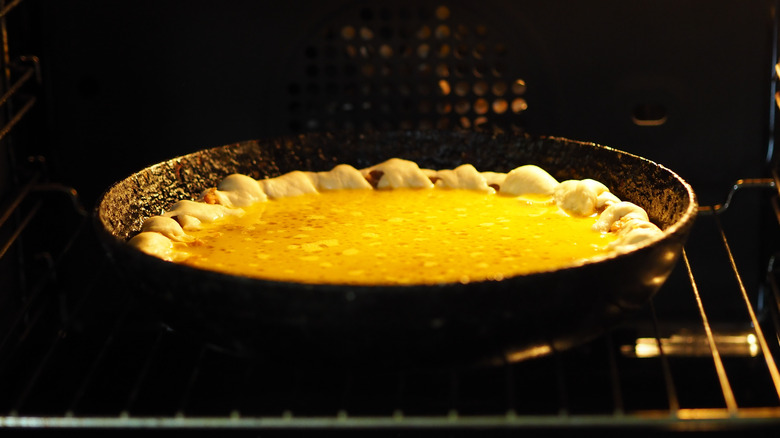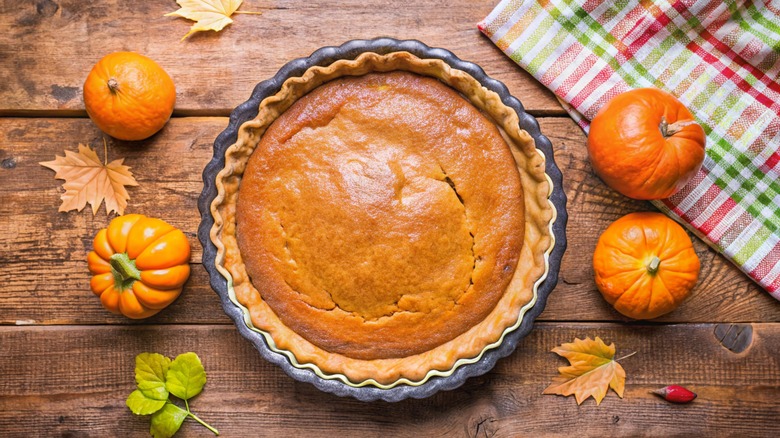Why Pumpkin Pie Always Tastes Better From A Bakery, According To Professional Bakers
Few dishes scream "holidays" like pumpkin pie. But, try as you might, your attempts never taste as good as your bakery favorites. Maybe your pastry has a soggy bottom or the filling is cracked and curdled. Or, perhaps it's technically decent but your spice blend doesn't approach the subtle balance of the pie from your favorite local bake shop.
The earliest pumpkin pie recipe dates back to 1653, although it was quite different from the ones that grace our Thanksgiving tables today. So, that has given professional bakers generations to hone their recipes. Some bakeries use family recipes while others have simply spent years perfecting theirs. Still, those aren't the only reasons why bakery pumpkin pies are better. We spoke to four professional bakers and pastry chefs to get the lowdown.
If you're wondering why pumpkin pie always tastes better from a bakery, you're in the right place. Although you can't match the years of experience and you're probably not about to fit your kitchen with a professional oven, there are some tips you can steal to make your homemade pies better. Or, just accept that professional bakers do it better and put an order in at your favorite bakery for a pumpkin pie.
Professional bakers are pastry-making experts
You might follow an easy pie crust recipe, but professional bakers are pastry-making experts. So, it's natural that their crust comes out better than yours. And, if you've been using a store-bought pie crust — forget about it. It's never going to reach the heights of pastry carefully made by the pros.
Most of the bakers we spoke to use a standard pie crust for pumpkin pie, rather than a cookie crust or puff pastry. Gan Suebsarakham, the co-founder and executive chef at Pop Pie Co. aims for pastry with a rich flavor and flaky texture. And, of course, because professional bakers make pies all the time, they're well practiced at getting perfect results every time, while home baked versions are more hit-or-miss.
Want to improve your pie crust? "I think the common mistakes people might make at home are butter temperature, flour selection, and overmixing," says Adriano Zumbo, a famous pastry chef and TV personality on shows such as "Sugar Rush" and "Zumbo's Just Desserts." He notes that the butter should be very cold to make pastry, so he freezes his butter and then grates it. Also, the flour should be low protein, so cake flour or all-purpose flour are your best bets. "Overmixing the dough can overdevelop the gluten and cause shrinkage and uneven results in baking," Zumbo adds.
There may be a mixture of butter and shortening in the pastry
You probably think that great pastry relies on an all-butter recipe but this isn't necessarily the case. Butter brings a lot of flavor to pastry, but many pastry chefs and professional bakers find they don't get the texture they want from butter alone. Instead, they get the best of both worlds by using a combination of butter and shortening.
"We use a standard pie crust that has half shortening and half butter in it," says Sherrie Tan, pastry chef at Sweet Mandy B's. "The shortening is for the flaky layers while butter is for flavor." Adriano Zumbo also uses a mix of butter and shortening. "I use a simple pie crust recipe for pumpkin pie," Zumbo tells us. "It's made with the majority of butter, and I add a percentage of shortening for stability and texture."
Although some baking pros do use just butter — including Gan Suebsarakham of Pop Pie Co. — using a combination of butter and shortening can help you achieve the flaky finish you've been aiming for without missing out on that buttery flavor. It's a great compromise that brings you the best features from each substance. Shortening is usually dairy-free, so if you're baking for someone vegan or dairy intolerant, you could opt to use shortening alone.
The pastry is blind baked in a bakery pumpkin pie
There are many ways you could be messing up your pumpkin pie — and one of them is not blind baking the crust. Anyone familiar with "The Great British Baking Show" will know all about soggy bottoms. It's a real problem with pies — the base is soft or doughy instead of crisp. But, it's easily solved with blind baking.
"For custard-based pies like pumpkin pies, I like to blind-bake so the pie crust can hold the structure while the moisture from the custard won't be absorbed by the crust too soon in the beginning," says Melody Hu, baker at Sweet Diplomacy. Gan Suebsarakham agrees that blind baking "ensures a crisp, golden base, even when filled with a wet custard like pumpkin."
But, what exactly is blind baking? Well, it's the act of baking your pastry before adding the fillings. With some pies, you add the filling to raw dough and bake the whole lot at the same time. But, some pies need to have their crust pre-baked to keep them from getting soggy. To do so, you need to bake the pastry in its pie pan for around 20 minutes. For the first 15 minutes you should cover the crust with baking parchment and a layer of baking beans or dried pulses to stop the pastry from puffing up.
Professional bakers know that canned pumpkin gives more consistent results
Although some experts say that making your own pumpkin purée is the key to great-tasting pumpkin pie, many professional bakers use canned pumpkin because of its consistent results. Sure, you could try leveling up your homemade pie with your own DIY purée — if you get it right, we bet it'll be delicious. But there are many ways it could go wrong. Using canned pumpkin purée is far more reliable. In fact, all the baking pros we spoke to use canned pumpkin for their pies.
"I like using high-quality canned pumpkin purée because the moisture level and flavors are very consistent," baker Melody Hu tells us. "Fresh pumpkins might have a higher water content or too many unprocessed fibrous parts, requiring more due diligence to make into a smooth custard with just the right texture." She says that it's doable but it takes a lot of work and there isn't necessarily a big flavor difference at the end.
For many people, Libby's is the canned pumpkin you should buy for your pie, however, there are many great brands. Any can of 100% pumpkin is sure to do the trick, but you might want to experiment to find your favorite. But, ditch that pumpkin pie mix because it's much better to add sugar and spices yourself.
Bakeries may use their own pumpkin spice blend
A classic pumpkin spice mix is a combination of cinnamon, nutmeg, cloves, and ginger. Occasionally, you might find allspice in the mix, too. You can find this spice blend in stores all over the country. But, many bakeries use their own blends. Sometimes, the difference is subtle. The ratio of spices used is individual to the bakery and gives their pie its own flavor, even if it isn't ground-breaking. But, other bakeries make unusual additions to their pumpkin spice blends, making them different from other pies around.
"I love cinnamon, ginger, cardamom, vanilla, tonka, pepper, and coffee," says Adriano Zumbo. This certainly isn't a classic blend but it keeps enough in common with the original that it retains the spirit of a standard pumpkin pie. Baker Gan Suebsarakham sticks to the classic mix of cinnamon, nutmeg, ginger, and cloves. "It's a warm, aromatic combination that's balanced to enhance the pumpkin flavor without overpowering it," he says.
Some bakeries are secretive about their blends — and we don't blame them. It's what makes their pies stand out. "We have a secret blend of pumpkin spice mix we make at the bakery to get our signature pumpkin pie taste that our customers love," says Sherrie Tan.
Pumpkin pie from a bakery is made to a recipe that's been tweaked and perfected over time
Home bakers might make two or three pumpkin pies a year, if that. Professional bakers, on the other hand, could bake thousands just over the Thanksgiving period. This gives them time to tweak their recipes until they're perfect. Not to mention the recipe will have gone through a long development stage before the pies even hit the market.
"We spend a lot of time testing and tweaking recipes to ensure the perfect balance of flavors and textures," Gan Suebsarakham of Pop Pie Co. tells us. "It's an ongoing process to refine each recipe with precision," he adds. Sherrie Tan of Sweet Mandy B's agrees. "We do spend a lot of time to perfect and continually evolve a recipe to make it better," she remarks. She adds that she and her colleagues sometimes also adapt recipes over time to fit in with the latest culinary trends and consumer preferences.
Plus, there are other places that recipes come from. "I can't speak for everyone, but some professional bakers use their favorite recipes passed down from generations," says Melody Hu. So, your favorite bakery could be making a pumpkin pie recipe that came from the founder's grandparents.
Commercial kitchens have access to equipment home bakers don't
It goes without saying: The equipment in bakeries and commercial kitchens is different to what you have at home. This can play a part in how your pie turns out. So, if you're wondering why pumpkin pie always tastes better from a bakery, this is at least part of the reason.
"Commercial ovens provide more consistent heat distribution, which ensures an even bake," says Gan Suebsarakham. "We also have precise temperature control, which helps when blind baking or baking custards like pumpkin pie." Sherrie Tan agrees that bakeries have "convection ovens that distribute even heat throughout the pie that a normal home oven cannot do as well."
But, you shouldn't let this put you off trying to make a pie as good as your bakery favorite. "Pie crusts and fillings are very technique-driven and not so much special equipment-driven, so with good recipes and knowing the basics of making a good pie crust dough, we can definitely make professional-quality pies at home," Melody Hu tells us. It might take a bit of work to perfect your recipes and techniques, but you can make an exceptional pumpkin pie if you want to. Or, you could just buy from your local bakery and save yourself the fuss.
Professional bakers are serious about high-quality ingredients
When you're making pumpkin pie at home, you probably pick up whatever ingredients you can find at the supermarket. For professional bakers, however, ingredient quality is paramount. They'll source the best ingredients they can get their hands on to make top-notch pies. You get out what you put in, so it tracks that the pies you get from bakeries are better,
"Ingredient quality is essential — it impacts flavor, texture, and the overall result," Gan Suebsarakham remarks. "For example, we use real butter and premium spices to elevate our pies," he adds. But, some ingredients make more of a difference than others. "In a wide variety of ingredients quality is key and finding the best available will elevate the pie in those areas, but for staples like sugar, salt and so on it's not super important," says Adriano Zumbo. "Butter, if you're using it, is also something where the quality really shines through in pie crusts," explains Melody Hu. She also prefers the flavor of unrefined sugar in her pies.
Professional bakers also think about where their ingredients come from. "I usually source my ingredients from local providers or distributors," notes Zumbo, adding that it's a bonus if you can source local ingredients. Suebsarakham also looks close to home when buying supplies. "We source high-quality ingredients locally whenever possible," he comments.
Bakery pumpkin pies are made to a simple recipe so the pumpkin shines
Ingredient quality matters, but you don't want to go overboard with unnecessary ingredients. In fact, most pros keep it fairly simple. This way, pumpkin remains the star of the show. If you go around adding a variety of extracts or other ingredients, it's no longer a classic pumpkin pie.
"I don't add any extracts other than vanilla and no flavorings to my pies, keep it as clean as a flavor as I can," Adriano Zumbo tells us. "I can't resist the famous 'warmth' of vanilla extract in my pumpkin pie filling," says Melody Hu, but she keeps it simple aside from that. Gan Suebsarakham forgoes extracts altogether. "We don't use extracts in our pumpkin pie filling," he remarks. "We focus on the natural flavor of the pumpkin and the richness of our spice blend to create a deep, warm flavor profile."
However, bakers also need to be careful to avoid using too much spice. According to Zumbo, too much spice "overpowers [the] pumpkin flavor." Again, it's a case of keeping the ingredients simple and pared-back so that you can taste the pumpkin. It's called pumpkin pie for a reason, after all. Winter squash should always be front-and-center, otherwise you might as well leave the pumpkin out and make a spiced egg custard pie.
Bakery pumpkin pie is never overbaked
The beauty of bakery pumpkin pie is that it's never overbaked. This kind of pie can be finicky — just a few too many minutes in the oven and it ruins the texture. Professional bakers are experienced enough that this rarely happens. And when it does, overbaked pies would never make it through quality control and end up in customers' hands.
Pastry chef Adriano Zumbo tells us that overbaking pumpkin pie is a common problem among home bakers. He says that it makes the texture of the filling unpleasant. Sherrie Tan of Sweet Mandy B's agrees that "overbaking the pumpkin pie [so] that the filling is curdled" is a common problem that people encounter. Overbaking can ruin an otherwise excellent pie.
But, how do you avoid overbaking your pie? The key is to keep an eye on it and know what to look out for to indicate that it's done baking. "Pumpkin pie should still have a slight jiggle in the center when removed from the oven," says Gan Suebsarakham. "It will continue to set as it cools," he explains. So, if you're waiting for your pie to look fully set in the center, you'll end up cooking it for too long and messing up the texture.
Bakeries use steam in the oven to stop the pie from cracking
Are you coveting the perfect finish of your favorite bakery pie? It's not uncommon for homemade pumpkin pies to end up with cracks in the top. They might still taste good, but it ruins the smooth, flawless finish. Well, the secret you might be missing is that bakeries often use steam in the oven to prevent cracks.
"A common mistake when people make custard-based pies like pumpkin pies is baking at high temperatures without any steam," Melody Hu of Sweet Diplomacy tells us. Some bakeries have steam-injected ovens that make this a breeze. But, you can achieve the same effect at home with a little ingenuity. "The trick is to bake at a lower temperature with a pan of water underneath so the steam cooks the custard evenly," explains Hu. She adds that "the lower temperature would prevent the custard from cracking on top."
Just be careful when you're baking with steam. It can rush out of the oven in large clouds when you open the door, causing scalds. Stand back when you open up the oven and wait a few seconds for the steam to dissipate before you attempt to grab your pie.
